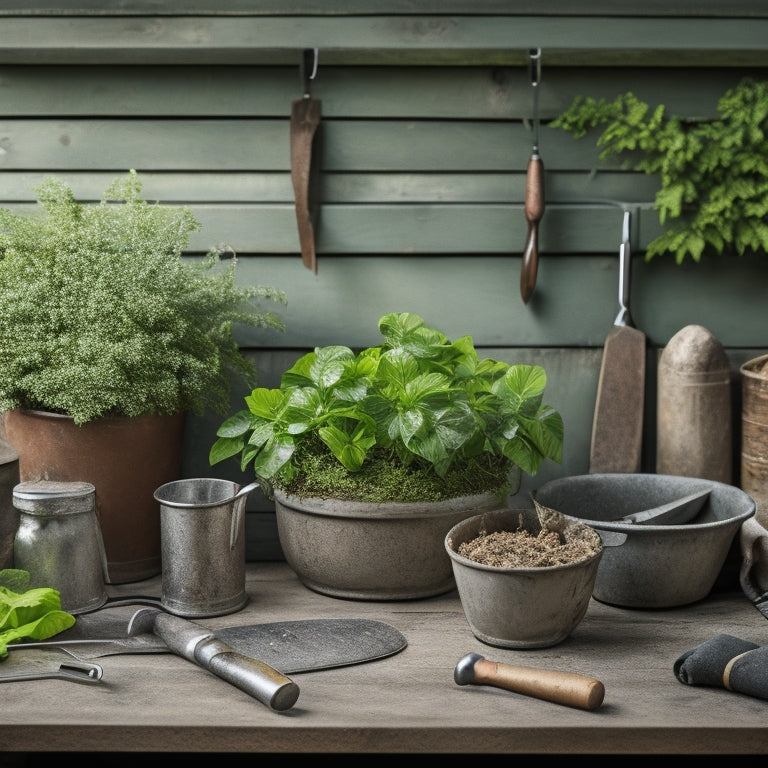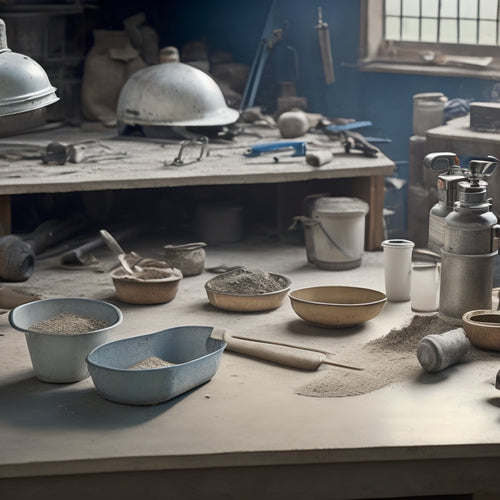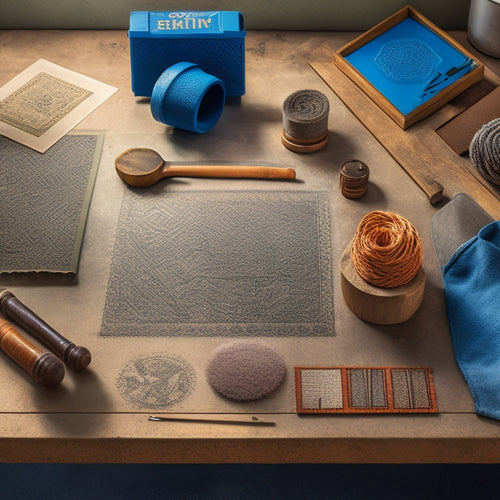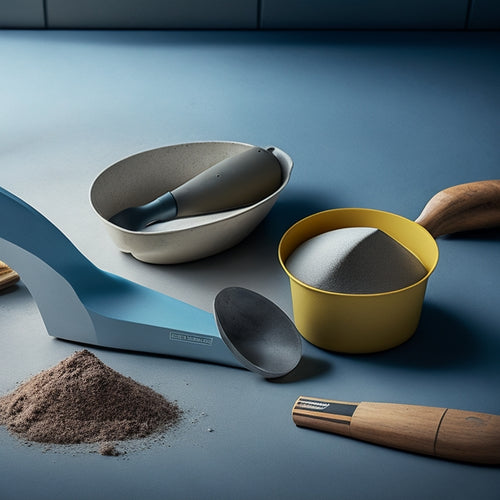
10 Must-Have Tools for Planters Made of Concrete
Share
When building concrete planters, you'll need essential tools to guarantee a sturdy, visually appealing, and long-lasting result. Start with safety gear like goggles, dust masks, and gloves to protect yourself from debris and chemicals. Next, gather measuring and marking tools, such as a high-quality tape measure and chalk line reel, to create precise designs. Then, move on to cutting and drilling equipment, like high-quality drill bits, and mixing and pouring essentials, including a reliable drill and mixing paddle. Additionally, you'll need tamping and compacting tools, sanding and finishing supplies, cleaning and preparation materials, adhesive and sealing materials, and reinforcement and anchoring tools. With these must-haves, you'll be well on your way to creating a beautiful, functional planter - and the road to success is paved with the details that follow.
Key Takeaways
• Safety gear like goggles, masks, gloves, and steel-toed boots is essential for protecting yourself from concrete mixing and handling hazards.
• Measuring and marking tools, including tape measures, chalk lines, and carpenter's pencils, ensure accurate planter design and layout.
• Mixing, pouring, and compacting tools, such as mixing buckets, drills, and tamping tools, are necessary for creating strong and even concrete.
• Sanding and finishing tools, including sandpaper, sanding blocks, and power sanders, help achieve a smooth and professional-looking finish.
• Adhesive and sealing materials, like waterproofing sealants and patching compounds, are crucial for bonding new concrete to existing surfaces and preventing damage.
Essential Safety Gear Checklist
As you prepare to plunge into the world of concrete planters, make certain you're equipped with the essential safety gear to protect yourself from the hazards that come with working with cement, chemicals, and heavy materials.
You don't want to risk injuring your eyes or respiratory system, so prioritizing safety gear is vital. First and foremost, invest in a good pair of safety goggles that can withstand flying debris and chemical splashes.
Next, get a reliable dust mask that can filter out airborne particles and cement dust, which can cause respiratory issues. Don't forget to choose a mask that fits snugly around your nose and mouth to guarantee maximum protection.
Additionally, consider wearing gloves, steel-toed boots, and a long-sleeved shirt to prevent skin irritation and cuts. By donning this essential safety gear, you'll be well-prepared to tackle your concrete planter project with confidence and peace of mind.
Measuring and Marking Tools
With your safety gear in place, you're ready to start preparing your workspace and materials, and that begins with accurately measuring and marking your concrete planter's dimensions.
To guarantee precision, you'll need reliable measuring and marking tools. Invest in a high-quality tape measure that can withstand rough handling and provide accurate readings. A 25-foot tape measure should suffice for most planter projects.
Next, grab a chalk line reel and a decent supply of chalk. This will help you create clear, straight lines on your concrete, making it easier to cut and shape your planter.
When marking your dimensions, use a carpenter's pencil or a marker specifically designed for concrete. These will leave a more visible mark than a standard pencil.
Remember to double-check your measurements before marking your concrete to avoid costly mistakes. By having these essential measuring and marking tools, you'll be able to create a precise planter design that meets your exact specifications.
Cutting and Drilling Equipment
When working with concrete planters, you'll need to make precise cuts and holes, which requires the right cutting and drilling equipment.
You'll want to select drill bits that can handle the dense, abrasive nature of concrete, and consider different cutting wheel options to achieve the desired finish.
Drill Bits Required
You'll need a set of high-quality drill bits specifically designed for cutting and drilling through concrete to create precise holes for drainage, anchoring, or decorative features in your planters. Choosing the right drill bit type is vital, as it directly affects the quality of your holes and the overall durability of your planters.
| Drill Bit Type | Purpose |
|---|---|
| Carbide-tipped | For drilling through hard, dense concrete |
| Diamond-coated | For drilling through reinforced concrete or concrete with rebar |
| Masonry bits | For drilling through brick, block, or soft concrete |
| Step bits | For drilling holes with varying diameters |
Regular drill bit maintenance is also essential to guarantee peak performance and extend the lifespan of your drill bits. Clean your drill bits regularly to remove debris and concrete residue, and store them in a dry place to prevent rust. Additionally, consider sharpening your drill bits periodically to maintain their cutting edge. By selecting the right drill bit type and maintaining them properly, you'll be able to achieve precise, professional-looking results in your concrete planters.
Cutting Wheel Options
Selecting the right cutting wheel for your concrete planter project is just as important as choosing the correct drill bit, as it allows you to make precise cuts and shapes in your concrete. You'll need a cutting wheel that can efficiently cut through the dense material without compromising its structural integrity.
Diamond blades are a popular choice for concrete cutting, as they provide a clean, precise cut and can be used for both wet and dry cutting. However, they can be expensive, especially for larger projects.
A more cost-effective option is abrasive wheels, which are designed for high-speed cutting and grinding. They're ideal for removing excess concrete, smoothing out rough edges, and making rough cuts.
When choosing an abrasive wheel, consider the grit size, as it affects the wheel's cutting speed and finish. A higher grit size will provide a smoother finish, but at a slower cutting speed.
Mixing and Pouring Essentials
To guarantee a strong, durable planter, you're mixing and pouring concrete that's precisely proportioned and thoroughly combined. This requires attention to detail and the right tools.
When it comes to mixing techniques, you'll need a sturdy mixing bucket, a reliable drill, and a mixing paddle or trowel. Start by adding the correct ratio of cement, sand, and water to the bucket, then use the drill and paddle to combine the ingredients until they're smooth and consistent. Be certain to scrape the sides and bottom of the bucket to prevent lumps from forming.
For pouring methods, you'll need a pouring jug or bucket with a spout, as well as a level and a trowel or screed. Pour the mixed concrete slowly and evenly into the planter mold, using the level to guarantee it's straight and the trowel or screed to remove any air pockets or excess concrete.
With the right tools and techniques, you'll be able to achieve a smooth, even finish that will give your planter a professional look.
Tamping and Compacting Tools
As you work to eliminate air pockets and excess water from the freshly poured concrete, a sturdy tamping tool and a compacting hammer become essential for ensuring a dense, uniform finish in your planter. These tools help you achieve the perfect balance of strength and aesthetics in your concrete planter.
When it comes to tamping techniques, you'll want to focus on applying even pressure to the concrete surface. This can be achieved by using a tamping tool with a flat or rounded edge, depending on the desired finish.
For compacting methods, you'll need a hammer that can deliver a controlled amount of force to the concrete. Here are some key considerations to keep in mind:
-
Choose a tamping tool with a comfortable grip to reduce fatigue
-
Select a compacting hammer with a durable striking surface
-
Use a gentle, consistent motion when tamping to avoid creating air pockets
- Apply compacting force in a controlled, incremental manner to avoid over-compacting
Sanding and Smoothening Tools
You'll shift gears from compacting to refining your concrete planter's surface with sanding and smoothening tools, which help erase any imperfections and bring out the desired texture. These tools are essential for surface preparation, allowing you to achieve a smooth, even finish. By mastering various sanding techniques, you'll be able to remove minor defects, such as air pockets or unevenness, and create a surface that's ready for finishing.
Here's a breakdown of the essential sanding and smoothening tools you'll need:
| Tool | Purpose | Grit Level |
|---|---|---|
| Sandpaper | Remove imperfections, smooth surface | 80-120 |
| Sanding block | Flatten surface, remove scratches | 120-220 |
| Steel wool | Polish surface, remove minor defects | Fine-Medium |
| Power sander | Efficiently sand large areas | 80-120 |
With these tools, you'll be able to refine your concrete planter's surface, creating a smooth, even finish that's ready for sealing or painting. By following proper sanding techniques and using the right tools, you'll achieve a professional-looking finish that showcases your craftsmanship.
Cleaning and Prepping Supplies
With your concrete planter's surface now smooth and even, it's time to clean away any residual dust and debris to confirm a strong bond between the concrete and subsequent coatings. This vital step guarantees that your planter's surface is free from contaminants, allowing for a strong and durable finish.
To achieve ideal results, you'll need the right cleaning and prepping supplies. Here are some essentials to add to your toolkit:
-
A soft-bristled brush or dusting brush to sweep away loose particles
-
A tack cloth or microfiber cloth to wipe down the surface, removing any remaining dust or debris
-
A degreaser or surface cleaner to remove any oils or residue
- A clean, lint-free rag to wipe away any excess moisture or cleaning solution
Adhesive and Sealing Materials
When working with concrete planters, you'll need adhesive and sealing materials to guarantee a strong and durable finish.
You'll use these products to bond new concrete to existing concrete, seal cracks and holes, and waterproof surfaces to prevent damage from the elements.
Bonding Concrete to Concrete
Bonding concrete to concrete requires a reliable adhesive and sealing system to guarantee a strong, long-lasting bond between the old and new concrete surfaces.
As you prepare to bond concrete, it's crucial to understand the importance of surface preparation and the role of bonding agents in achieving a successful bond.
To guarantee a strong bond, you'll need to:
-
Clean the surface of the old concrete to remove dirt, oil, and other contaminants
-
Etch the surface to create a rough texture for the new concrete to adhere to
-
Apply a bonding agent to the prepared surface to create a strong chemical bond
- Mix and apply the new concrete according to the manufacturer's instructions
Sealing Cracks and Holes
You'll need to seal any cracks and holes in your concrete planters to prevent water seepage and damage, and that's where the right adhesive and sealing materials come in. For effective crack repair, you'll want to use a high-strength, flexible sealant that can withstand the natural expansion and contraction of concrete. Look for a product that's specifically designed for concrete and can bond well with the surrounding material.
When it comes to hole filling, you'll need a material that can provide structural integrity and durability. A high-build, fast-setting concrete patching compound is ideal for filling holes of various sizes. Make sure to choose a product that's compatible with the type of concrete you're working with and follows the manufacturer's instructions for application and curing times.
Remember to always clean and prepare the surface before applying any adhesive or sealing material. Remove any debris or dirt, and roughen the surface to guarantee a strong bond.
Waterproofing Concrete Surfaces
To guarantee your concrete planters remain impervious to water and moisture, applying a waterproofing sealant to the surface is essential, as it prevents seepage and damage from the inside out. A waterproofed surface guarantees that your plants receive the right amount of moisture, without compromising the structural integrity of the planter.
When selecting a waterproofing sealant, you'll want to evaluate products that offer superior adhesion, flexibility, and UV resistance.
Here are some key characteristics to look for:
-
High bonding strength to prevent delamination
-
Resistance to hydrostatic pressure and water absorption
-
Compatibility with concrete and other construction materials
- Easy application and maintenance procedures
Reinforcement and Anchoring Tools
Several reinforcement and anchoring tools are vital for creating durable and long-lasting concrete planters that can withstand environmental elements and support the weight of soil and plants.
You'll need to incorporate reinforcement techniques, such as adding rebar or fiber mesh, to strengthen your planter's structure and prevent cracking. Anchoring methods, like anchor bolts or screw anchors, will guarantee your planter remains secure and stable.
When choosing reinforcement materials, consider the planter's size, shape, and intended use. For example, larger planters may require heavier-duty rebar, while smaller ones might need lighter-weight fiber mesh.
It's also important to select anchoring methods that suit your planter's design and the surface it'll be placed on.
Finishing and Decorating Supplies
With your concrete planter's structure and anchorages in place, it's time to focus on the aesthetic aspects, applying finishing and decorating supplies that bring out the beauty and character of your unique creation.
Now, you'll want to add those final touches that make your planter truly stand out.
To achieve the desired look, you'll need a range of finishing and decorating supplies. These include:
-
Decorative paints to add pops of color or subtle textures
-
Surface finishes like sealers, waxes, or varnishes to protect and enhance the concrete
-
Stencils or stamping tools to add intricate patterns or designs
- Adhesives and fasteners for attaching decorative elements like mosaics or tiles
Frequently Asked Questions
Can I Use Concrete Planters Outdoors in Extreme Weather Conditions?
You're wondering if concrete planters can withstand harsh outdoor conditions. The answer is, it depends on the planter's weather resistance.
If you're using a high-quality, weather-resistant concrete mix, your planter can handle extreme temperatures and moisture.
Consider adding planter insulation to protect the roots from freezing temperatures or scorching heat.
With proper preparation, your concrete planter can thrive outdoors, even in the most unforgiving weather.
How Do I Prevent Concrete Planters From Cracking Over Time?
Carefully craft a cracking prevention plan to safeguard your concrete planters from the cruel claws of time.
First, apply a waterproof sealant to shield the surface from moisture.
Next, perform regular concrete maintenance by cleaning and inspecting for signs of wear.
Are Concrete Planters Suitable for Plants With Acidic Soil?
When you're considering concrete planters for plants with acidic soil, you'll want to think carefully.
Acidic soil can erode concrete over time, so it's essential to monitor soil pH levels.
Additionally, you'll need to guarantee proper drainage to prevent waterlogged soil, which can exacerbate drainage issues.
Can I Paint or Stain Concrete Planters for Decoration?
'Measure twice, cut once' - wise words to live by when decorating your concrete planters.
You can definitely paint or stain them for a personalized touch. Before you start, make sure the surface is clean and dry.
Consider using specialized concrete painting techniques, such as faux finishing or stenciling, to add texture and visual interest.
For a more subtle look, explore staining options like acid-based or water-based stains that can enhance the natural beauty of the concrete.
Are Concrete Planters Safe for Edible Plants and Vegetables?
When you're thinking of using a concrete planter for edible plants and veggies, safety is top priority.
You'll want to make sure the concrete is completely cured and sealed to prevent leaching of harmful chemicals into the soil. Additionally, avoid using planters with metal reinforcements, as they can contaminate the soil.
With proper preparation, a concrete planter can be a safe and healthy haven for your edible plant growth. You'll be enjoying fresh, chemical-free produce in no time!
Conclusion
You've finally gathered all the must-have tools for creating stunning concrete planters. Congratulations!
You're now well-equipped to transform a messy mixture of cement, sand, and water into a beautiful work of art.
But, let's be real – the real fun begins when you're knee-deep in concrete dust, with a drill screaming in your ear, and a realization dawns that you might've bitten off more than you can chew.
Happy crafting!
Related Posts
-

What Tools Do You Need for Concrete Success
For concrete success, you'll need a range of essential power tools, including rotary hammers, angle grinders, concret...
-

5 Best Tools for Stamping Concrete Walls
When it comes to stamping concrete walls, you'll need a range of specialized tools to achieve the desired texture and...
-

Ergonomic Concrete Tools for Tight Spaces
When you're tackling concrete work in tight spaces, ergonomic tools are your best bet for comfort and efficiency. The...


